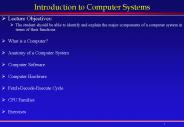Computer Graphics Normal, Texture, Supersampling Exercises - PowerPoint PPT Presentation
1 / 6
Title:
Computer Graphics Normal, Texture, Supersampling Exercises
Description:
Normal, Texture, Supersampling Exercises - Marcus Magnor ... Invertible if points are non-collinear. Computer Graphics WS05/06 Supersampling Exercises ... – PowerPoint PPT presentation
Number of Views:43
Avg rating:3.0/5.0
Title: Computer Graphics Normal, Texture, Supersampling Exercises
1
Computer Graphics- Normal, Texture,
Supersampling Exercises -
- Marcus Magnor
2
Vertex Normals
- Normal vector per vertex
- E.g., averaged orientations of adjoining
triangles - Normalized
- Normal interpolation in triangle
- Hitpoint position in barycentric coordinates
(u,v,1-u-v) - Barycentric interpolation cf. lecture
raytrace1, slide 36 - Re-normalize interpolated normal vector
3
Surface Parameterization
- Some objects have a natural parameterization
- Sphere spherical coordinates (?,f) (2p u, p v)
- Cylinder cylindrical coordinates (?,z) (2p u,
H v) - Parametric surfaces (such as B-spline or Bezier
surfaces) - Parametrization less obvious for
- Polygons
- Implicit surfaces
4
Triangle Parameterization
- Piecewise planar object surface patches
- To each vertex (xo,yo,zo) assign texture
coordinates (u,v) - Viewing projection (xo,yo,zo) ? (x,y)
- Yields warping operation (u,v)?(x,y)
- In homogeneous coordinates
- Transformation coefficients determined by 3 pairs
(u,v)?(x,y) - Invertible if points are non-collinear
5
Triangle Parameterization II
- Inverse transform (x,y)?(u,v)
- Transformation coefficients must be calculated
for each triangle - Scan-line rendering
- Bilinear interpolation of (u,v,q) in screen
space - Ray tracing
- Evaluation at each intersection
6
Supersampling
- Regular
- Subdivide pixel into sub-areas
- Send one ray through each sub-areas center
- Average
- Random
- N rays through pixel area at (quasi-)random 2D
positions - average
- Stratified
- Combination of former two
- Subdivide pixel into sub-areas
- Send one ray through each sub-area at (quasi-)
random 2D position - average































